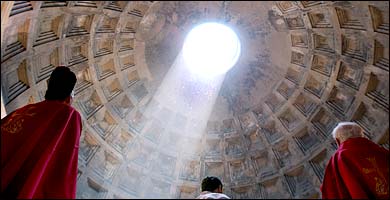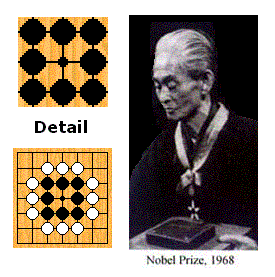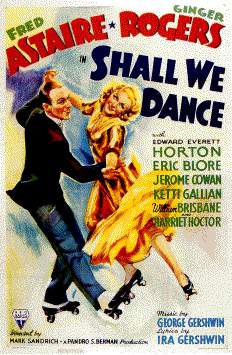ART WARS
for St. Peter's Day
Compare and contrast:

Pigi Cipelli for The New York Times

|
ART WARS
for St. Peter's Day
Compare and contrast:

Pigi Cipelli for The New York Times

|
|
When? Going to dark bed there was a square round Sinbad the Sailor roc's auk's egg in the night of the bed of all the auks of the rocs of Darkinbad the Brightdayler. Where?
— Ulysses, conclusion of Ch. 17 |
A Visual Meditation for
the Feast of St. Peter

For further details on this structure, see
Magic Squares, Finite Planes,
and Points of Inflection
on Elliptic Curves,
by Ezra Brown, and
Visualizing GL(2, p)
by Steven H. Cullinane.
For a more literary approach
to this structure, see
Balanchine's Birthday (Jan. 9, 2003),
Art Theory for Yom Kippur (Oct. 5, 2003),
A Form (May 22, 2004),
Ineluctable (May 27, 2004),
A Form, continued (June 5, 2004),
Parallelisms (June 6, 2004),
Deep Game (June 26, 2004), and
Gameplayers of Zen (June 27, 2004).

To appreciate fully this last entry
on Gameplayers,
one must understand
the concept of "suicide"
in the game of Go
and be reminded
by the fatuous phrase of the
Institute of Contemporary Art
quoted in Gameplayers —
"encompassed by 'nothing' " —
of John 1:5.
Gameplayers of Zen
"The void, the ineffable, the sublime,
nonsense, nihilism, zero—
all are encompassed by
— Institute of Contemporary Art,
Philadelphia
"The Zen disciple sits for long hours silent and motionless, with his eyes closed. Presently he enters a state of impassivity, free from all ideas and all thoughts. He departs from the self and enters the realm of nothingness. This is not the nothingness or the emptiness of the West. It is rather the reverse, a universe of the spirit in which everything communicates freely with everything, transcending bounds, limitless."
— Yasunari Kawabata, Nobel lecture, 1968

Herman Goldstine (left), shown in 1952
at the Institute for Advanced Study
with J. Robert Oppenheimer (center)
and John von Neumann (right).
Click on the picture above
for an obituary in today's New York Times
of Goldstine, who died on June 16, 2004.
Click on the picture below
for an event appropriate to
the date of Goldstine's death.
The event, a talk on black holes, took place at
the American Philosophical Society in Philadelphia.
Goldstine was executive director of the Society
from 1984 to 1997.
The entry Ado of June 25, 2004 contains a link to an earlier entry, A Form, continued, of June 5, 2004. This in turn contains a link to a site by Wolfgang Wildgen which contains the following:
“Historically, we may say that the consequence of Bruno’s parallel work on cosmology and artificial memory is a new model of semantic fields which was so radical in its time that the first modern followers (although ignorant of this tradition) are the Von-Neumann automata and the neural net systems of the 1980s (cf. Wildgen 1998 : 39, 237f).”
: 39, 237f).”
 Wildgen, W. 1998. Das kosmische Gedächtnis. Kosmologie, Semiotik und Gedächtniskunst im Werke von Giordano Bruno. Frankfurt/Bern: Lang.
Wildgen, W. 1998. Das kosmische Gedächtnis. Kosmologie, Semiotik und Gedächtniskunst im Werke von Giordano Bruno. Frankfurt/Bern: Lang.
Gedächtniskunst:

Figure A
Neighborhood in a
Cellular Automaton
by Adam Campbell
For more of the Gedächtnis
in this Kunst, see the following
Google search on shc759:

Figure B
Note that the reference to “forerunners” in fig. B occurs in a journal entry of June 12, 2002. See also the reference to a journal entry of the following day, June 13, 2002, in last Tuesday’s Dirty Trick.
Those who have viewed Campbell’s applet (see fig. A) may appreciate the following observation of poet and Dante translator Robert Pinsky:
— Poetry, Computers, and Dante’s Inferno
For some related remarks
on the muses and epic poetry,
see a paper on Walter Benjamin:
“Here the memory (Gedächtnis) means
‘the epic faculty par excellence.’ “
(Benjamin, Der Erzähler, 1936: in
Gesammelte Schriften, 1991, II.2, 453)
Click on above picture
for some background.

Click on above picture
for some background.
Related material:
A Form (May 22, 2004),
A Form, continued (June 5, 2004),
Balanchine’s Birthday (Jan. 9, 2003),
Pictures of Nothing (Aug. 23, 2003)
Dirty Trick
Some quotations in memory of philosopher Stuart Hampshire, who died on June 13, 2004.
From the Hampshire obituary in The Guardian:
|
I He frequently told the story of how, towards the end of the war, he had to interrogate a French traitor (imprisoned by the Free French), who refused to cooperate unless he was allowed to live. Should Hampshire, knowing the man was condemned to die, promise him a reprieve, which he was in no position to give, or truthfully refuse it, thereby jeopardising the lives of Resistance fighters? “If you’re in a war,” said Hampshire, “you can’t start thinking, ‘Well I can’t lie to a man who’s going to be shot tomorrow and tell him that he isn’t.’ ” But what the whole anecdote, and its incessant retelling, revealed was that Hampshire had, in fact, thought precisely what he said was unthinkable, and that whichever of the two decisions he finally took lay heavy on his conscience ever afterwards. Indicatively, too, it was especially loathsome to him because, although he did not say this in so many words, the traitor was almost a mirror image of himself – a cultivated young intellectual, looking like a film star, much influenced by elegant literary stylists – except that, in the traitor’s case, his literary mentors were fascist. II It is hard to know how Hampshire’s academic career was vitiated by the scandal over his affair with Ayer’s wife Renee, whom he married in 1961 after a divorce in which he was named as co-respondent. Even if less a matter of the dons’ moral conviction than their concern over how All Souls would appear, the affair caused a massive furore…. |
From a log24 entry on the day before Hampshire’s death:
|
I “Hemingway called it a dirty trick. It might even be an ancient Ordeal laid down on us by an evil Inquisitor in Space…. the dirty Ordeal by — Jack Kerouac in Desolation Angels II The New Yorker of June 14 & 21, 2004: …in ‘The Devil’s Eye,’ Bergman’s little-known comedy of 1960. Pablo seduces the wife of a minister, and then, sorrowful and sated, falling to his knees, he addresses her thus: ‘First, I’ll finish off that half-dug vegetable patch I saw. Then I’ll sit and let the rain fall on me. I shall feel wonderfully cool. And I’ll breakfast on one of those sour apples down by the gate. After that, I shall go back to |
Whether Hampshire is now in Hell, the reader may surmise. Some evidence in Hampshire’s favor:
His review of On Beauty and Being Just, by Elaine Scarry, in The New York Review of Books of November 18, 1999. Note particularly his remarks on Fred Astaire, and the links to Astaire and the Four Last Things in an earlier entry of June 12, which was, as noted above, the day before Hampshire’s death.
As for the day of death itself, consider the following remark with which Hampshire concludes his review of Scarry’s book:
“But one must occasionally fly the flag, and the flag, incorrigibly, is beauty.”
In this connection, see the entry of the Sunday Hampshire died, Spider Web, as well as entries on the harrowing of hell — Holy Saturday,
Ishtar Wannabe
Reuters, Los Angeles,
June 17, 2004 09:09 PM ET—
Madonna Louise Veronica Ciccone has adopted the Hebrew name Esther.
I personally feel that a more deserving candidate for such a flattering name change would be Piper Laurie (nee Rosetta Jacobs).
See an entry of Dec. 30, 2002, on Miss Laurie:
|
From Robert A. Heinlein’s Glory Road: Her face turned thoughtful. “Would you like to call me ‘Ettarre’?” “Is that one of your names?” “It is much like one of them, allowing for different spelling and accent. Or it could be ‘Esther’ just as closely. Or ‘Aster.’ Or even ‘Estrellita.’ “ ” ‘Aster,’ ” I repeated. “Star. Lucky Star!” |

Kierkegaard on death:
“I have thought too much about death not to know that he cannot speak earnestly about death who does not know how to employ (for awakening, please note) the subtlety and all the profound waggery which lies in death. Death is not earnest in the same way the eternal is. To the earnestness of death belongs precisely that capacity for awakening, that resonance of a profound mockery which, detached from the thought of the eternal, is an empty and often brash jest, but together with the thought of the eternal is just what it should be, utterly different from the insipid solemness which least of all captures and holds a thought with tension like that of death.”
— Works of Love,
Harper Torchbooks, 1964, p. 324
For more on “the thought of the eternal,” see the discussion of the number 373 in Directions Out and Outside the World, both of 4/26/04.
“… as an inscription over the graveyard gate one could place ‘No compulsion here’ or ‘With us there is no compulsion.’ “
— Works of Love,
Harper Torchbooks, 1964, p. 324
“In the summer of 1943 I was eight, and my father and mother and small brother and I were in Peterson Field in Colorado Springs. A hot wind blew through that summer…. There was not much to do…. There was an Officers’ Club, but no swimming pool; all the Officers’ Club had of interest was artificial blue rain behind the bar. The rain interested me a good deal, but I could not spend the summer watching it, and so we went, my brother and I, to the movies.
We went three and four afternoons a week, sat on folding chairs in the darkened Quonset hut which served as a theater, and it was there, that summer of 1943 while the hot wind blew outside, that I first saw John Wayne. Saw the walk, heard the voice. Heard him tell a girl in a picture called War of the Wildcats that he would build her a house, ‘at the bend in the river where the cottonwoods grow.’ As it happened I did not grow up to be the kind of woman who is the heroine in a Western, and although the men I have known have had many virtues and have taken me to live in many places I have come to love, they have never been John Wayne, and they have never taken me to that bend in the river where the cottonwoods grow. Deep in that part of my heart where the artificial rain forever falls, that is still the line I wait to hear.
… When John Wayne spoke, there was no mistaking his intentions; he had a sexual authority so strong that even a child could perceive it. And in a world we understood early to be characterized by venality and doubt and paralyzing ambiguities, he suggested another world, one which may or may not have existed ever but in any case existed no more: a place where a man could move free. could make his own code and live by it; a world in which, if a man did what he had to do, he could one day take the girl and go riding through the draw and find himself home free, not in a hospital with something wrong inside, not in a high bed with the flowers and the drugs and the forced smiles, but there at the bend in the bright river, the cottonwoods shimmering in the early morning sun.”
— Joan Didion,
“John Wayne: A Love Song,” 1965
“He is home now. He is free.”
— Ron Reagan, Friday, June 11, 2004
“Beware, therefore, of the dead! Beware of his kindness; beware of his definiteness, beware of his strength; beware of his pride! But if you love him, then remember him lovingly, and learn from him, precisely as one who is dead, learn the kindness in thought, the definiteness in expression, the strength in unchangeableness, the pride in life which you would not be able to learn as well from any human being, even the most highly gifted.”
— Works of Love,
Harper Torchbooks, 1964, p. 328
Don Giovanni, Part II
(See entries of June 8, 2004,
and June 4, 2004.)
Ingmar Bergman long ago
"earned the nickname of
the 'demon director,'
such are the demands that
he makes on his performers."
— Anthony Lane in
The New Yorker,
June 14 & 21, 2004

AFP/GETTY IMAGES
Ingmar Bergman
on the set in
the late 1940's
From the entry of
June 4 last year:
Commentary by Jack Kerouac,
from an entry of May 21, 2004:
"So what do we all do in this life which comes on so much like an empty voidness yet warns us that we will die in pain, decay, old age,
"… listen to the words of Pablo, the servant of Don Juan, who is summoned from the underworld in 'The Devil's Eye,' Bergman's little-known comedy of 1960. Pablo seduces the wife of a minister, and then, sorrowful and sated, falling to his knees, he addresses her thus:
'First, I'll finish off that half-dug vegetable patch I saw. Then I'll sit and let the rain fall on me. I shall feel wonderfully cool. And I'll breakfast on one of those sour apples down by the gate. After that, I shall go back to Hell.' "

“Who’s got the last laugh now?”
— “They All Laughed,”
words by Ira Gershwin,
music by George Gershwin,
from the 1937 film Shall We Dance
(sung by Ginger Rogers,
then danced by
Fred Astaire and Ginger Rogers)

See also
the entry of June 4 last year,
The Four Last Things.

Critics in Mozart’s age
threw up their hands
at the dark Don Giovanni,
calling it perverse, amoral.
These days, such qualities
turn us on… more»

Paul Klee,
The Bavarian Don Giovanni,
1919, watercolor and ink
on paper

There’s a little black spot
on the sun today….
(See Feel Lucky?, June 4)
Anomaly
|
Robert Quine, 61, By BEN SISARIO Robert Quine, a noted guitarist of the New York rock scene of the 1970’s and 80’s who played with Richard Hell, Lou Reed and others, died last week in his home in Manhattan. He was 61. He was found dead by the police on Saturday, said James Marshall, a friend. The police found a note and said they believed the death was a suicide but are awaiting a medical examiner’s report. Mr. Marshall said he believed Mr. Quine died on May 31. In the loud world of New York punk, where crude simplicity trumped most conventional notions of musical skill, Mr. Quine stood out as a stylish virtuoso…. “He was an extraordinary mixture of taste, intelligence, and rock ‘n’ roll abilities, coupled with major technique and a scholar’s memory for every decent guitar lick ever played under the musical sun,” Mr. Reed said…. Mr. Quine was an anomaly in the punk scene. Older than most of his fellow musicians, he had a law degree and was nearly bald, and wore button-down shirts and sport coats and described his appearance as that of a “deranged insurance salesman.”…. His uncle, the philosopher W. V. Quine, died in 2000. |
| “Anomalies must be expected along the conceptual frontier between the temporal and the eternal.” — The Death of Adam, by Marilynne Robinson, Houghton Mifflin, 1998, essay on Marguerite de Navarre “D’exterieur en l’interieur entre |
“He was trained by the British MI6
intelligence agency for an operation
known as X2 – or ‘double cross.’ “
|
From Fritz Leiber’s
“Damnation Morning,” 1959:
Bordered version The sigil was an eight-limbed asterisk made of fine dark lines and about as big as a silver dollar. An X superimposed on a plus sign. It looked permanent…. … “Here is how it stacks up: You’ve bought your way with something other than money into an organization of which I am an agent….” “It’s a very big organization,” she went on, as if warning me. “Call it an empire or a power if you like. So far as you are concerned, it has always existed and always will exist. It has agents everywhere, literally. Space and time are no barriers to it. Its purpose, so far as you will ever be able to know it, is to change, for its own aggrandizement, not only the present and the future, but also the past. It is a ruthlessly competitive organization and is merciless to its employees.” “I. G. Farben?” I asked grabbing nervously and clumsily at humor. She didn’t rebuke my flippancy, but said, “And it isn’t the Communist Party or the Ku Klux Klan, or the Avenging Angels or the Black Hand, either, though its enemies give it a nastier name.” “Which is?” I asked. “The Spiders,” she said. That word gave me the shudders, coming so suddenly. I expected the sigil to step off her forehead and scuttle down her face and leap at She watched me. “You might call it the Double Cross,” she suggested, “if that seems better.” |
|
From
The Man in the High Castle by Philip K. Dick Juliana said, “Oracle, why did you write The Grasshopper Lies Heavy? What are we supposed to learn?” “You have a disconcertingly superstitious way of phrasing your question,” Hawthorne said. But he had squatted down to witness the coin throwing. “Go ahead,” he said; he handed her three Chinese brass coins with holes in the center. “I generally use these.” She began throwing the coins; she felt calm and very much herself. Hawthorne wrote down her lines for her. When she had thrown the coins six times, he gazed down and said: “Sun at the top. Tui at the bottom. Empty in the center.”
“Do you know what hexagram that is?” she said. “Without using the chart?” “Yes,” Hawthorne said. “It’s Chung Fu,” Juliana said. “Inner Truth. I know without using the chart, too. And I know what it means.” From 12:5 … and the almond tree shall flourish, and the grasshopper shall be a burden, and desire shall fail: because man goeth to his long home, and the mourners go about the streets
|
From a review of On the Composition of Images, Signs & Ideas, by Giordano Bruno:
|
Proteus in the House of Mnemosyne (which is the fifth chapter of the Third Book) relies entirely on familiarity with Vergil’s Aeneid (even when the text shifts from verse to prose). The statement, “Proteus is, absolutely, that one and the same subject matter which is transformable into all images and resemblances, by means of which we can immediately and continually constitute order, resume and explain everything,” reads less clear than the immediate analogy, “Just as from one and the same wax we awaken all shapes and images of sensate things, which become thereafter the signs of all things that are intelligible.” |
From an interview with Vladimir Nabokov published in Wisconsin Studies in Contemporary Literature, vol. VIII, no. 2, Spring 1967:
|
When I was your student, you never mentioned the Homeric parallels in discussing Joyce’s Ulysses But you did supply “special information” in introducing many of the masterpieces: a map of Dublin for Ulysses…. Would you be able to suggest some equivalent for your own readers? Joyce himself very soon realized with dismay that the harping on those essentially easy and vulgar “Homeric parallelisms” would only distract one’s attention from the real beauty of his book. He soon dropped these pretentious chapter titles which already were “explaining” the book to non-readers. In my lectures I tried to give factual data only. A map of three country estates with a winding river and a figure of the butterfly Parnassius mnemosyne for a cartographic cherub will be the endpaper in my revised edition of Speak, Memory. |

From Lullus to Cognitive Semantics:
The Evolution of a Theory of Semantic Fields
by Wolfgang Wildgen and in
Another Page in the Foundation of Semiotics:
A Book Review of On the Composition of Images, Signs & Ideas, by Giordano Bruno…
by Mihai Nadin
“We have had a gutful of fast art and fast food. What we need more of is slow art: art that holds time as a vase holds water: art that grows out of modes of perception and whose skill and doggedness make you think and feel; art that isn’t merely sensational, that doesn’t get its message across in 10 seconds, that isn’t falsely iconic, that hooks onto something deep-running in our natures. In a word, art that is the very opposite of mass media. For no spiritually authentic art can beat mass media at their own game.”
— Robert Hughes, speech of June 2, 2004
Whether the 3×3 square grid is fast art or slow art, truly or falsely iconic, perhaps depends upon the eye of the beholder.
For a meditation on the related 4×4 square grid as “art that holds time,” see Time Fold.
 This entry was inspired by the following…
This entry was inspired by the following…
1. A British blogger’s comment today. This man, feeling like a miserable failure himself, was cheered up by the following practical joke: “If really fed up you could try putting in, miserable failure, (no quote marks) into Google and pressing the ‘I’m feeling lucky’ button.”
2. The page, excerpts from which are shown above, that you get if you put lucky (no quote marks) into Google and press the “I’m feeling lucky” button.
3. My own entries of May 31 on Language Games and of June 1 on language and history, Seize the Day and One Brief Shining Moment.
4. The related June 1 entry of Loren Webster, Carpe Diem, on the Marilyn Monroe rose. Images from Carpe and Shining are combined below:

7. Yesterday’s entry about the alignment of stars, combined with the alignment of Venus with Apollo (i. e., the sun) scheduled for June 8.
All of the above suggest the following readings from unholy scripture:
A. The “long twilight struggle” speech of JFK
B. “The Platters were singing ‘Each day I pray for evening just to be with you,’ and then it started to happen. The pump turns on in ecstasy. I closed my eyes, I held her with my eyes closed and went into her that way, that way you do, shaking all over, hearing the heel of my shoe drumming against the driver’s-side door in a spastic tattoo, thinking that I could do this even if I was dying, even if I was dying, even if I was dying; thinking also that it was information. The pump turns on in ecstasy, the cards fall where they fall, the world never misses a beat, the queen hides, the queen is found, and it was all information.”
— Stephen King, Hearts in Atlantis, August 2000 Pocket Books paperback, page 437
C. “I will show you, he thought, the war for us to die in, lady. Sully your kind suffering child’s eyes with it. Live burials beside slow rivers. A pile of ears for a pile of arms. The crisps of North Vietnamese drivers chained to their burned trucks…. Why, he wondered, is she smiling at me?”
— Robert Stone, A Flag for Sunrise, Knopf hardcover, 1981, page 299
STAR WARS
Continued…
|
Today’s New York Times story on Richard Helms, together with my reminiscences in the entry that follows it below, suggest the following possibility for symbol-mongering:
|

Not even the most powerful
can alter the alignment
of the stars.
In a related story….
The Good Bad Boy
By Alison Lurie
“Today, many people have the illusion that they know who Pinocchio is. They think that he is a wooden marionette who becomes a human boy; that he was swallowed by a huge fish; and that when he told lies his nose grew longer. These people are right, but often in a very limited way. They know Pinocchio only from the sentimentalized and simplified Disney cartoon, or the condensed versions of his story that are thought more suitable for children. The original novel by Carlo Collodi, which today survives mainly in scholarly editions, is much longer, far more complex and interesting, and also much darker.”
— The New York Review of Books, June 24, 2004

William Manchester, author of the JFK book with the above title, died today at 82.
Seize the Day
From a March 31 entry —
A Jesuit cites Quine:
“To be is to be the value of a variable.”
— Willard Van Orman Quine, cited by Joseph T. Clark, S. J., in Conventional Logic and Modern Logic
For example, the variable
in the Crystal Software program EasyPattern Helper supposedly helps to find any valid day number, 1-31, within a date, by first translating “[Day]” into the regular expression
(?:(?:0?[1-9]|[12]\d|3[01])).
But it turns out that this expression fails to find the day “22” — at least during a trial run in the EasyPattern Helper search window.
The following seems apt:
“A tongue-in-cheek comment by programmers is worth thinking about: ‘Sometimes you have a programming problem and it seems like the best solution is to use regular expressions; now you have two problems.’ Regular expressions are amazingly powerful and deeply expressive. That is the very reason writing them is just as error-prone as writing any other complex programming code.”
— David Mertz, Learning to Use Regular Expressions
The following irregular expression also seems apt:
&3#!+*^$#!!
Powered by WordPress